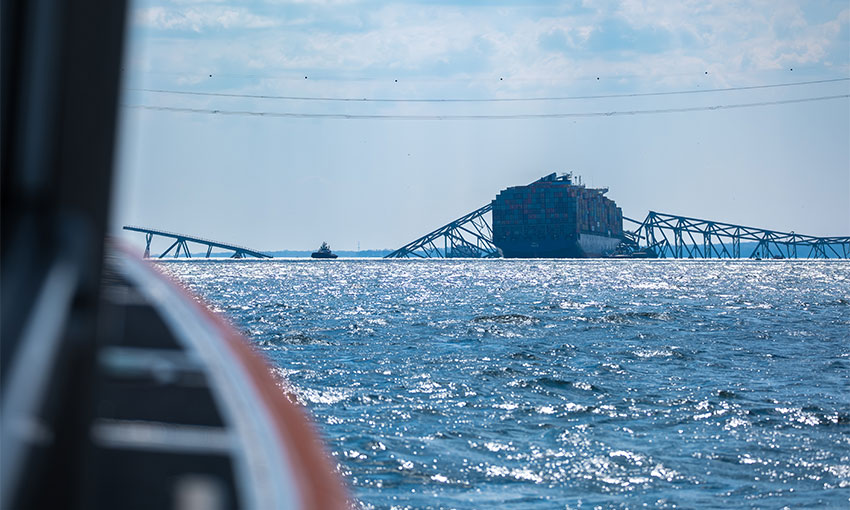THE PRELIMINARY report of the US National Transportation Safety Board into containership Dali’s allusion with Baltimore’s Francis Key Scott Bridge has found the ship suffered a number of electrical failures several hours and immediately prior to the prang.
About 10 hours before the ship’s departure for Colombo the first and second blackouts occurred alongside during routine maintenance, when a crewmember mistakenly closed an exhaust damper while conducting maintenance, causing one of the ship’s diesel generators to stall.
The No. 2 was the only generator running (out of the four aboard), so the ship experienced a brief blackout until the crew could bring power back online with the No. 3 generator. After a short period, the No. 3 generator experienced loss of fuel pressure and its breaker opened, prompting a second blackout alongside the pier.
When the ship departed the pier early the next morning, the No. 3 and No. 4 generators were running, and most of the equipment that had caused problems at the pier the day before (save for the No. 3 generator) was offline.
The ship left the pier at 0036, released the tugs, turned and slowly headed outbound in Fort McHenry Channel.
At about 0125, as Dali was about three ship lengths away from the Francis Scott Key Bridge, the No. 1 high and low voltage breakers both opened and cut off all power to the rest of the ship. The reasons are unknown and are under investigation, with help from the manufacturer, the NTSB said.
The two auxiliary engines kept running, uninterrupted, but they were no longer connected to the rest of the ship’s systems. Without power to the electrically-driven lube oil pump and coolant pump for the main engine, the propulsion system automatically shut down. It was never brought back online.
Rudder control was also temporarily lost, and the rudder was stuck amidships as Dali drifted towards the bridge. The emergency generator started up shortly after and restored power to bridge systems and to one steering pump for rudder control. At 0126:13, the senior pilot ordered 20 degrees port rudder. This had a reduced effect on the ship’s trajectory, since the propeller was no longer pushing water past the rudder.
The crew manually reconnected the high voltage and low voltage breakers, restoring full power to the vessel. At 0126:39, the pilots called for an urgent tug assist and ordered an anchor dropped.
Shortly after, the ship lost electrical power again. This time, the diesel generator breakers for the No. 3 and 4 generators had opened, cutting off the still-running auxiliaries from the high voltage bus. The emergency generator stayed on and kept providing backup power to the bridge. The No. 2 generator was running on standby and quickly connected automatically, and the crew closed the breakers for the No. 2 transformer (the one previously in use the day before) to bring back low-voltage power for the second time. From the start of the second blackout to the restoration of power took about 30 seconds.
At 01:29:10, Dali struck the southwest pier of the Key Bridge’s main span at 6.5 knots, dropping the entire six-span truss into the water. One crewmember sustained a minor injury when the bridge deck hit Dali’s bow, six road crew workers were killed and one worker was injured.
Meanwhile, the U.S. Coast Guard Captain of the Port has reopened the Fort McHenry Limited Access Channel in Baltimore to 48 feet to commercial vessel traffic.
The reopened channel will operate daily from 8 p.m. to 6 a.m., featuring a controlling depth of 48 feet, a 350-foot horizontal clearance, and a 214-foot vertical clearance due to nearby BG&E powerlines. Deep draft vessels using the channel will require the assistance of a Maryland State Pilot and two escort tugs.
Given the ongoing salvage operations, all transits must not exceed 5 knots while Dali is in place and less than 10 knots after it is refloated.





